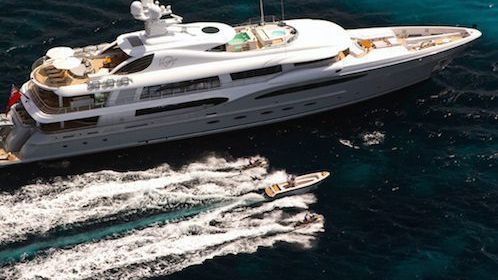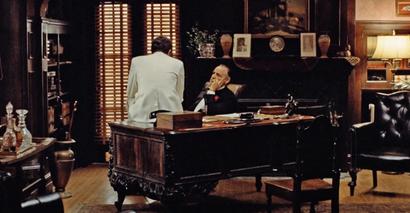

The private jets and yachts that are in a different league
Words: Gentleman's Journal
When cruising on the water or flying at 40,000ft, luxury comes at a serious price. It is the privilege of the mega-rich, and therefore designing these mobile palaces is something of a bespoke art, as Teresa Levonian Cole discovers.
“All our projects are homes, whether they are houses, yachts or private jets,” says Andrew Winch, of the eponymous design company. His office overlooks a leafy stretch of the River Thames, and contains an eclectic collection of artworks, including a Picasso ceramic, “which was bought for a client, but he didn’t like it”. The studios themselves, sleekly contemporary, contain drawings and models of the company’s projects in departments dedicated to yachting, aviation and architecture. Among these is a model of the blue-hulled, 99m Madame Gu, which was named Motor Yacht of the Year in 2014, by a unanimous panel of 20 judges.
“There is a lot of cross-fertilisation between departments,” says Winch. “A client who likes what we did with his yacht may well ask us to design his house, or his private jet, too.”
With 65 employees spanning 16 nationalities to service a global client base, Winch Design can claim to be one of the foremost custom designers of mobile homes in the world.
Things have changed since Winch designed his first yacht – a Swan 36 sailing boat – in 1986; not least, the notion of a mobile home, which once referred to something towed along the slow lane of a motorway. “You could say the concept of designed yachts and jets began with Jon Bannenberg in the 1960s,” says Winch of his mentor, the late designer, for whom he once worked on projects that included a custom-made Boeing 727 for Malcolm Forbes to transport his hot air balloons around the world, as part of a publicity stunt. The difference, today, is one of size and usage. Among their current projects is a motor yacht “150m-plus” which will contain over 300 pieces of custom-designed furniture; and a private Boeing 787-9 Dreamliner, whose commercial equivalent would typically carry 280 passengers. Discretion within the industry is such, however, that several designers were unwilling to discuss their work. Winch himself will not even divulge the nationality of a client, saying only that they come from as far afield as “China, Russia, South America and the Middle East”.
“We are not permitted to show photographs of interiors, unless the yacht is also available for charter,” continues Winch, whose brief extends to providing art through fine art consultant Stephen Clarke. Along with purchasing works by Matisse, Picasso, Chagall, Modigliani and Henry Moore, Winch has commissioned pieces from contemporary artists – Damien Hirst, Marc Quinn, and Dale Chihuly, among others. Access can present logistical problems: the suspended Chihuly sculpture, for example, required the assembly of over 1,000 pieces of glass, weighing over one ton, aboard the 133m Al Mirqab. Winch is particularly proud of a 34sq.m. educational Tree of Life designed in-house for Sea Owl and featuring North American wildlife. Sculpted from Brazilian mahogany, it required seven man-years to carve, extending from its roots embedded in the floor of the lower deck, over four storeys to branches on the sun deck.
“One particular yacht is now said to contain artwork which is valued at more than the yacht itself,” says James Carroll of Winch Design. The cost of the yacht? As a guideline, Winch suggests a starting price of £50 million for a 60m European-built motor yacht. “One can estimate £1 million per metre for those between 50-70m. With larger yachts, cost grows exponentially, and becomes more a question of gross tonnage.”
As expected, standards of finish, ‘owner supplied’ items and fancy extras – such as a recording studio (Octopus), a fully-equipped hospital (Equanimity), sophisticated security system (Eclipse), a €5m AV system, and the de rigueur panoply of on-board planes, helicopters, and submarines – have a bearing on costs, as do technical challenges such as a waterfall (Quite Essential), or an internal seawater dock for a 14m tender (Ocean Victory).
Peter Lürssen, head of the 140-year-old family-owned German shipyard, is tasked with turning such dreams into reality. Lürssen shipyard has built seven of the top 20 superyachts, including the world’s largest: the 180m Azzam, whose almost 100,000 horsepower engines propel the craft to an extraordinary top speed of 31kph.
“We are currently building a 25-metre indoor wave pool on one yacht,” he says, as an example. “It is technically very complicated. The sea moves, and the pool water moves, but not in sync. So we do special tank tests, to control the water movement in the pool. And there’s the climatic challenge of heating it to 28°C.”
The desire to recreate land-based facilities and foundation-free palatial splendour is not exactly new. One of the most opulent yacht interiors, utilising a medley of gold, lapis lazuli, onyx, jade, mother-of-pearl, ivory, coral and marbles, is that created by Jon Bannenberg for Cedar Sea II, in 1986, while the award for infamous exotica remains with Onassis’ Cristina O, whose bar stools were covered in whale foreskin. According to Winch, a more recent development is the demand for “timeless originality” – such as the structural use of glass, for a seamless flow between interior and exterior – along with a trend for environmentally-friendly motor yachts. As well as sophisticated filtration systems, waste management and rapidly-advancing battery technology, exterior design and structural materials can reduce environmental impact by up to 30 per cent.
A case in point is the 65m Galactica Star whose ground-breaking all-aluminium build and hull design maximises both speed (28kph) and fuel efficiency, marrying function with a supremely elegant contemporary interior by the award-winning Bannenberg & Rowell Studio. Viareggio Superyachts (VSY), meantime – a shipyard founded in 2004 – whose yachts’ exteriors have been designed by Monaco-based Espen Øino – has made sustainability the guiding principle of the company. Their yachts – such as the 72m Stella Maris, with its double-deck glass-enclosed winter garden – have all won environmental accreditation. “Our aim is to create quiet, odourless, smokeless vessels and a 20 per cent reduction in CO2 emissions,” according to Francesco Bono of VSY’s technical department.
If superyachts are primarily for leisure, private jets are considered business tools, saving valuable time by flying direct between far-flung countries, while satellite systems ensure this Billionaire’s Club has instant access to financial data at 39,000 feet. Here, too, size matters. As clients require longer-range aircraft with an ever-increasing array of facilities, jet owners are upgrading their Gulfstreams and Bombardier Globals – the largest private airline in the world now being an Airbus A380, complete with rotating prayer room to face Mecca, belonging to Saudi Prince Alwaleed bin Talal.
“We have clients who spend 48 hours a week in the air,” says Winch. “It therefore must be a comfortable, personal environment. And due to strict regulations, the weight of materials, and complexity of engineering involved, aircraft interiors are the most expensive interiors you can build. You cannot put a bath on a plane, for example, and showers must have an enclosed water system, with enough water for a single shower, which is cleaned and recycled.”
Even before the interior is styled (and a single lavatory can cost $75,000, as the 2012 Nemtsov Report revealed in a survey of Putin’s assets and purported 43 private jets) the hidden costs are enormous. “To create comfort, humidity, pressure, air flow, sound insulation and static are among the issues to be addressed,” says Winch. “On a commercial Boeing 737, for example, you couldn’t do this, as you need to maximise passengers. But a private 737 could take the extra weight involved, as you don’t have passenger numbers to consider.”
With such costs, even before the addition of custom-made luxuries and artworks, Winch Design quotes the cost of a Boeing 737-800 or Business Jet (BBJII) as approximately $60 million, with upwards of $30 million ear-marked for the interior, depending on the level of specification. This rises to $250 million for the shell of the 787-9 he is currently designing, with interior design estimated at $100-$300 million.
There are reports of one private jet owner who had Michelangelo’s Sistine ceiling replicated in his Boeing. The sky, it seems, is the limit. But, though yachts mimic mansions and planes mimic yachts, the prospect of an airborne swimming pool, at least, will not be realised any time soon.
All photos by Winch Design


